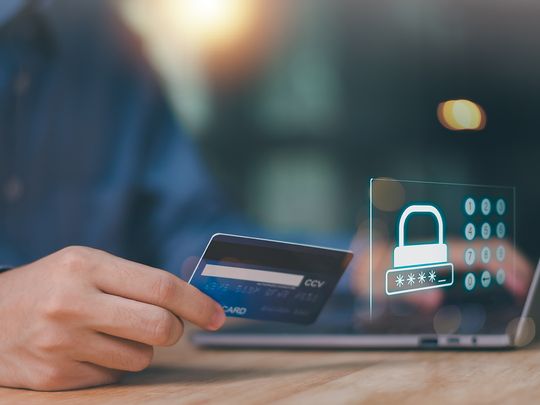
Dubai: Have you ever taken a closer look at your credit or debit card receipts whenever you have made a transaction? You would have noticed that only a portion of the cardholder's card number is printed. The remainder of the number is masked with an asterisk ‘*’.
“Aside from the first or last few digits, when an asterisk is printed for each of the remaining digits of the number on any transaction made either digitally or at retail outlets or kiosks, a security feature known as ‘credit card masking’ is at play,” explained Dubai-based credit advisor Michelle Trenor.
“With every transaction you make or initiate, instead of your personal credit card information, a disposable, timed, or virtual credit card number is created on the digital-end – each time you tap your card at a machine or feed your digits online when shopping. This reduces risk of fraudulent card use.
“These virtual card numbers are what the merchants see online or what is reflected on your in-app transactions. So it is safer way to pay online or in-app as they exist only in a virtual form. Although no one can see the number up front, the masked number tagged to the card’s account is 16 digits-long.”
How is a masked or virtual card number used?
When you make a purchase in an app with your mobile device or online, you may be able to fill out the form automatically with a virtual card. However, this is conditional on whether or not your card allows this safety feature, noted Essam Kabeelali, an Abu Dhabi-based credit advisor.
“If you check out with an eligible card not saved to your account, you may get the option to turn on a virtual card before you complete your purchase. But if you check out with an eligible card saved to your account, you may get the option to turn on a virtual card after you complete your purchase,” he added.
“Like ordinary credit card transactions, you’ll find a small ‘pending transaction’ on your account. This temporary authorisation is a standard practice to confirm that your payment method works. Your account isn’t charged and your bank may take 5-7 business days to release account authorisations.”
Why is a credit masking important to users?
As identity theft continues to plague credit card holders worldwide, credit masking through virtual card numbers can provide some peace of mind to its users without complicating the process for making payments and earning transaction related rewards.
“As it grows more important to protect privacy, credit masking presents one way for consumers and businesses alike to manage funds and purchases with enhanced spending controls and reporting tools while minimising security risks from both ends of a transaction,” added Trenor.
“By implementing credit masking technology has to offer, consumers, banks, and retailers have been dealing with fewer fraud charge claims, numerous surveys show. Those learning how to build credit such as younger family members may benefit from using these types of cards when transacting online.”
Credit masking different from how e-wallet works?
It’s important to distinguish between virtual cards created for the purpose of masking your credit card number and digital wallets, which is another way to securely store your card number, explained Kabeelali.
“While many credit cards offer different options designed to better protect your data and make purchases faster, a digital wallet or any information-storing technology is not the same thing as a virtual card set up to mask your credit card,” he explained.
“At first glance, digital and virtual cards might seem interchangeable, but their distinctions lie in tangibility and generation. Digital cards have a physical form while virtual cards are purely digital entities. Both types, however, rely on technology to enhance financial transactions.”
“So while a virtual card brought on by credit masking is stored on your phone and can be used to pay in stores or online, and has its own unique card number, expiry date, and CVC, it is merely a copy of your physical bank card that's stored on your phone,” added Trenor.
Are there any risks to using a virtual card number?
“While such a credit masking token is more secure than your actual credit card number because it means your card number isn’t seen by the merchant, that token can only be used with a unique, encrypted code (set up by your wallet) that gets applied to each individual transaction.”
While virtual cards are great when used as a spending control, they do have some limitations. The main downside to credit card masking or a virtual credit card is that it can only be used online, so it is not usable in all scenarios and is most worthwhile for those who do a lot of their spending online.
“Virtual card numbers may not be ideal for online purchases you’re planning to pick up in person. If you have to swipe or show your card to verify your identity, your actual card number won’t match the virtual number,” added Kabeelali.
“This could apply to situations involving tickets that are collected in-person, hotel reservations and pickup orders. There might be similar issues with in-store returns, too. If one of these situations applies to your purchase, it may help to reach out to the company before buying.”
Key takeaways?
• A virtual card provides a temporary or masked credit card number linked to your actual credit card. This number can be used for online purchases, and it may expire or be deactivated after a certain period.
• When viewing a credit card number online (e.g., through a mobile banking app or in transaction history), only the last four digits are often displayed, with the rest of the digits masked by asterisks (****).
• This involves replacing sensitive card details with a unique identifier or token. The token is meaningless on its own but can be used by the payment processor to retrieve the real credit card number for transactions.
Bottom line? Credit card masking offers significant benefits by improving security, reducing exposure to fraud, and protecting users' privacy. By masking sensitive information like card numbers and using virtual cards, users can control how and where information is shared, making online and offline payments safer.












